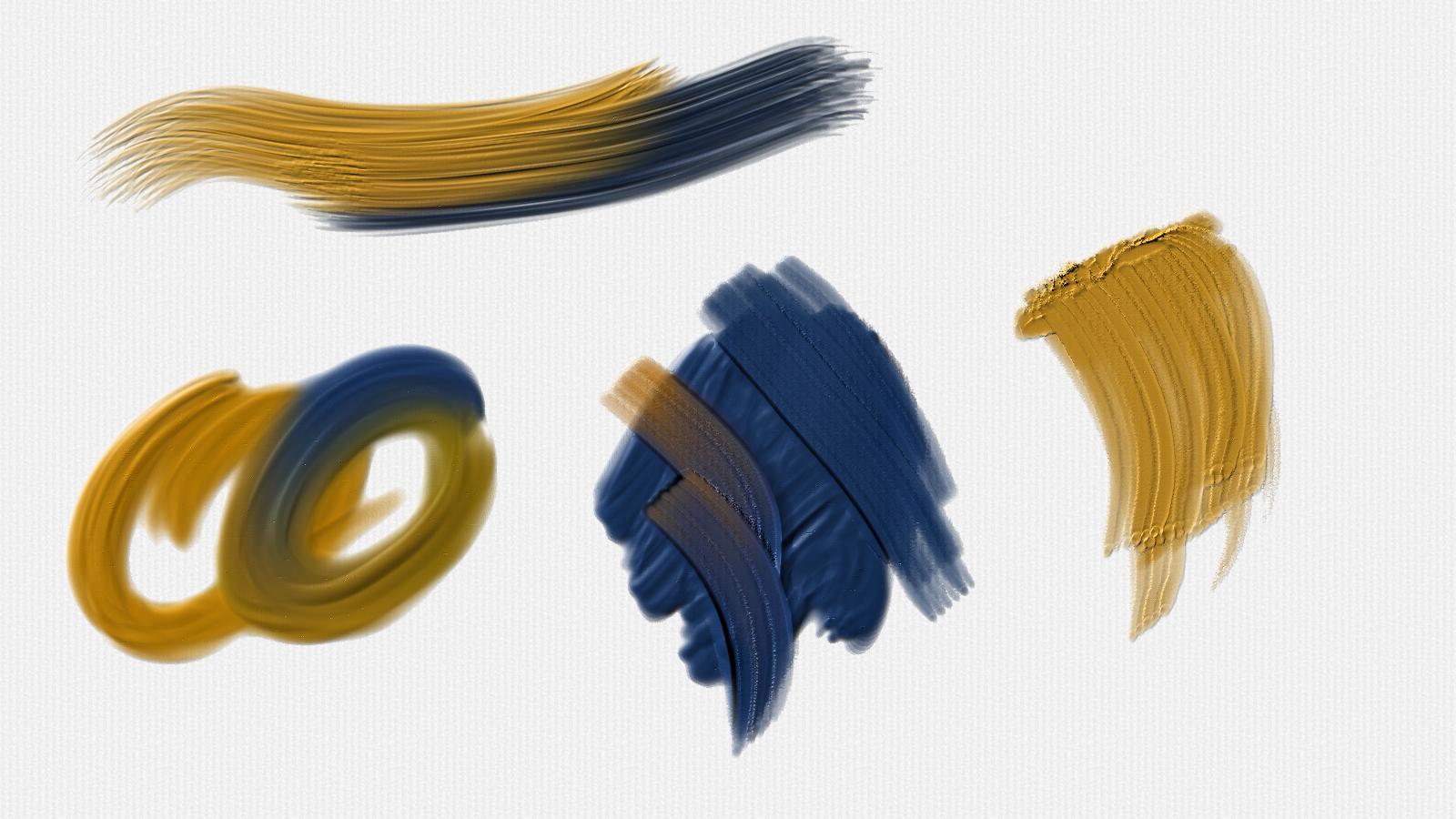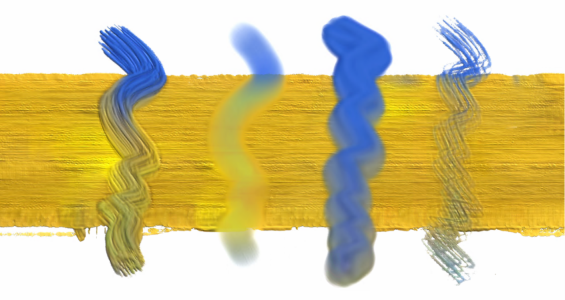Painting with Thick Paint
There are two types of Thick Paint brushes: bristle brushes and palette knives. Bristle brushes let you apply thick paint while simulating the movement of a traditional artist brush; palette knives let you scrape, push, and drag colors in your image.
Sample brushstrokes with Thick Paint : Bristles (left) and Thick Paint : Palette Knives (middle and right)
To find a brush that has the specific shape or mark you need, browse the Thick Brush variants accessible from the Brush Selector.
Once you find the brush you want, you can start painting. You can also quickly adjust brushstroke appearance by accessing presets and other controls from the property bar.
Depending on the technique you want to use, you can choose from the following presets:
Thick lets you add thick, rich brushstrokes that have a very pronounced impasto effect.
Soft lets you apply smooth, flat, and fluid brushstrokes that are ideal for adding detail to an image or filling large areas.
Thin lets you apply thin brushstrokes that lightly cover existing strokes and can reveal some paper texture.
Dry lets you paint long, crisp brushstrokes, with visible bristle marks. With this preset, you can use the brush to skim the surface, applying a light touch to create fully opaque brushstrokes. You can also use Dry for brushstrokes that drag existing paint.
Brushstrokes made with the same brush but with different technique presets applied: Thick, Soft, Thin, and Dry.
Most Thick Paint brushes are loaded with a certain amount of paint. You can adjust the amount of paint on your Thick Paint brush before you start painting. That way, you don’t need to interrupt your painting to refill with paint.
Special Thick Paint brush controls let you customize your brushstrokes and create your own Thick Paint brushes. These controls are grouped into three panels: Thick Paint - Media, Thick Paint - Shape, and Thick Paint - Wetness. The Media controls let you customize the paint applied by the Thick Paint brush. The Shape controls let you customize the behavior of the brush. The Wetness controls let you customize the interaction of Thick Paint with the canvas. Most controls are common for Thick Paint Bristle brushes and Thick Paint Palette Knife brushes. For more information, see Thick Paint - Media controls, Thick Paint - Shape controls, and Thick Paint - Wetness controls.
In addition, you can add RealBristle features to your Thick Paint Bristle brushes. For more information about RealBristle features, see Modifying RealBristle settings.
You can also improve the brush performance of Thick Paint brushes.
To paint with a Thick Paint brush
To choose a Thick Paint technique
To load a Thick Paint brush with paint
You can create a custom shortcut to access the Paint Load control. Choose Corel Painter 2022 menu ![]() Preferences
Preferences ![]() Customize Keys (macOS) or Edit
Customize Keys (macOS) or Edit ![]() Preferences
Preferences ![]() Customize Keys (Windows). From the Shortcuts (Windows) or Shortcuts for (macOS) list box, choose Other. In the list of Application Commands, scroll down to the Thick Paint Load (onscreen) command. In the Shortcut column next to the command, type the shortcut keys you want to assign. Click OK. If the shortcut you assigned is already in use, a message appears below the Application Commands list. To proceed, click one of the following:
Customize Keys (Windows). From the Shortcuts (Windows) or Shortcuts for (macOS) list box, choose Other. In the list of Application Commands, scroll down to the Thick Paint Load (onscreen) command. In the Shortcut column next to the command, type the shortcut keys you want to assign. Click OK. If the shortcut you assigned is already in use, a message appears below the Application Commands list. To proceed, click one of the following:
You can also load paint onscreen by using keyboard shortcuts, similarly to the way you can change brush attributes such as size, opacity, squeeze, and angle. First, hold down Command + Option (macOS) or Ctrl + Alt (Windows), and drag in the document window to resize the brush. Release the keys without releasing the mouse button or lifting the stylus, and then press Command (macOS) or Ctrl (Windows) several times to cycle through opacity, squeeze, and angle until the Paint Load control is displayed. Next, drag in the document window to load the brush.





